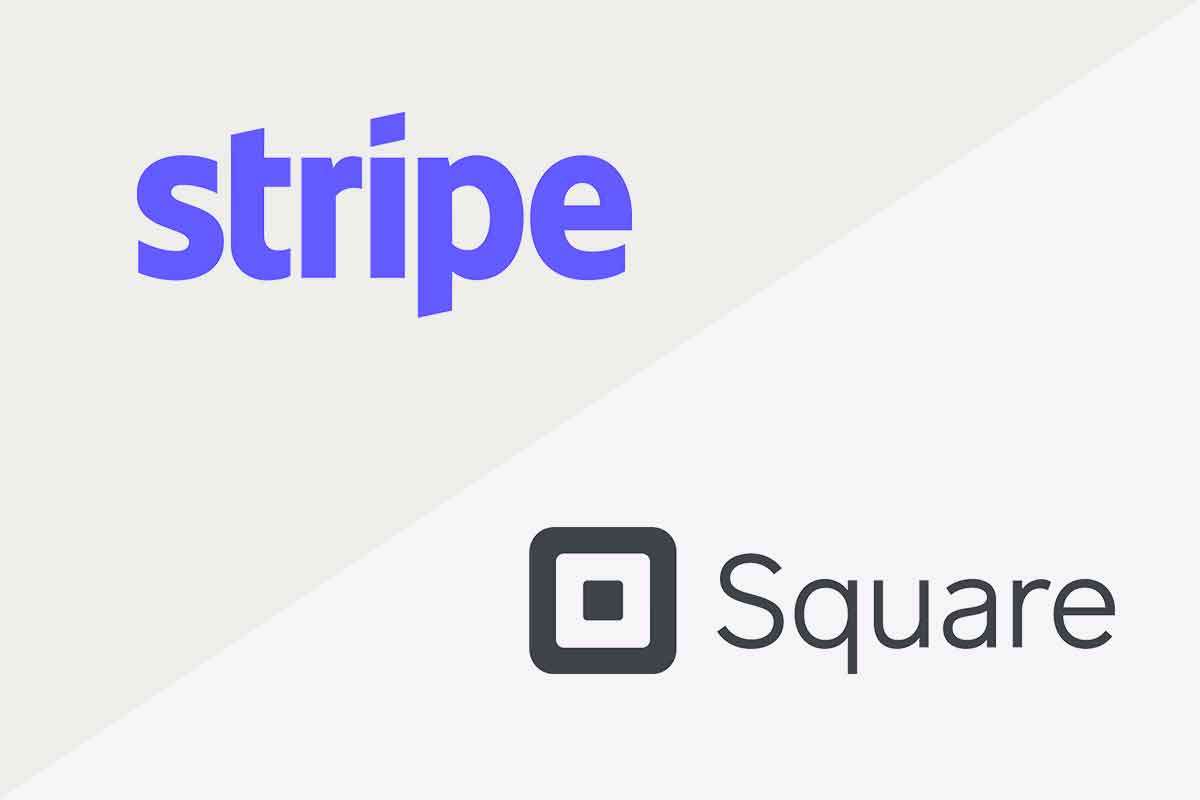In the dynamic world of e-commerce, ensuring smooth payment processing is of utmost importance for any business. This need becomes even more crucial when it comes to small and medium-sized enterprises (SMEs), where seamless transactions are vital to customer experience. Among the numerous payment processors available in the market, Stripe vs Square are two leading options that are consistently highly-rated.
Understanding their offerings, strengths, weaknesses, and compatibility with different business models can help you decide which is the most suitable for your enterprise.
Featured pro tools
Stripe vs Square
| Stripe | Square | |
|---|---|---|
| Setup Fees | £0 | £0 |
| Monthly Fees | £0 | £0 |
| Transaction Fees (European cards) | 1.4% + 20p | 1.75% (in-person), 2.5% (online) |
| Transaction Fees (Non-European cards) | 2.9% + 20p | 2.5% |
| International Transactions | Available, fees apply | Limited, fees apply |
| Point of Sale (POS) System | Available, not a primary focus | Comprehensive system with various hardware options |
| Invoicing | Free | Free |
| Receipts | Digital (free) | Digital (free), Printable (requires compatible printer) |
| Recurring Billing | Yes | Yes |
| Refunds | Free, but initial transaction fees aren’t returned | Free, including initial transaction fees |
| Chargebacks | £15 | £0 |
| API | Comprehensive and fully-customisable | Available, but not as comprehensive |
| Integrations | Extensive | Extensive |
| Payment Methods | Credit cards, debit cards, Apple Pay, Google Pay, ACH, and more | Credit cards, debit cards, Apple Pay, Google Pay, and more |
| Customer Support | 24/7 email support, extensive online resources | Phone support during business hours, email, comprehensive online resources |
| Security | PCI DSS Level 1, encryption, tokenisation, optional paid fraud detection | PCI DSS Level 1, encryption, tokenisation, built-in fraud detection |
It’s always recommended to visit the service provider’s website or contact them directly for the most accurate and up-to-date information.
Overview of Stripe vs Square
Stripe and Square have emerged as frontrunners in the payment processing landscape due to their robust platforms, wide range of features, and competitive pricing structures.
Stripe – A comprehensive API-based solution
Launched in 2010, Stripe is a technology-driven company that provides a suite of payment services, primarily catering to online businesses. Its key strength lies in its powerful application programming interface (API), which allows for a high level of customisation. This flexibility makes it an excellent choice for businesses with unique or evolving needs.
 |
Wallester Business ✓ Virtual & Physical Cards ✓ No Setup Fees ✓ No Monthly Fees Pricing Trial period Contact |
|
 |
Revolut Business ✓ Business Current Account ✓ Award-Winning Mobile App ✓ Quick & Easy Application Process Pricing Trial period Contact |
|
 |
Tide Business Bank Accounts ✓ Free, Plus, or Pro Account ✓ iOS & Android Mobile App ✓ Upload & Auto-Match Receipts Pricing Trial period Contact |
|
 |
Card One Money ✓ No Credit Checks ✓ Simple Fees ✓ Up to 3.5% Cashback Pricing Trial period Contact |
|
 |
ANNA Money ✓ Apply in 10 minutes ✓ Bookkeeping & Payroll Tools ✓ User-Friendly Mobile App Pricing Trial period Contact |
|
 |
Co-Op Business Banking ✓ Business Current Account ✓ Online, App & High Street Banking ✓ Quick & Easy Application Process Pricing Trial period Contact |
|
 |
HSBC Business Banking ✓ Business Current Account ✓ In-Branch, Online & App Banking ✓ FSCS Protected Pricing Trial period Contact |
|
 |
Metro Business Banking ✓ Business Current Account ✓ High Street Presence ✓ FSCS Protected Pricing Trial period Contact |
|
 |
Mettle Business Banking ✓ Business Bank Account ✓ Online & App ✓ Quick & Easy Application Process Pricing Trial period Contact |
|
 |
Monzo Business Banking ✓ Business Current Account ✓ Dedicated mobile app experience ✓ FSCS Protected Pricing Trial period Contact |
|
 |
Virgin Money ✓ Business M Account ✓ In-Store, Online & App Banking ✓ Insights & Forecasting Platform Pricing Trial period Contact |
Square – An all-round solution for brick-and-mortar stores
On the other hand, Square, founded in 2009, is renowned for its point-of-sale (POS) hardware and software solutions. The company has carved a niche for itself among small businesses and retailers, with its simple setup process and user-friendly interfaces.
Comparing offerings – Features and services
While both Stripe and Square offer comprehensive payment processing solutions, they cater to somewhat different business needs due to their unique service offerings.
API and integration capabilities – Stripe shines
Stripe’s robust API sets it apart from many competitors. Its APIs are thoroughly documented, making it easy for developers to customise payment processing according to specific needs. Additionally, Stripe offers compatibility with a vast range of third-party applications and services, allowing businesses to integrate a comprehensive range of functionalities.
POS and in-person sales – Square’s forte
Square’s strength lies in its POS hardware and software. It provides a range of POS hardware including card readers, terminals, and stands. For brick-and-mortar stores that also sell online, Square offers a unified system that seamlessly syncs online and in-store sales.
Stripe vs Square – Pricing models
Stripe’s pricing
Stripe operates on a pay-as-you-go model, charging a flat rate of 1.4% + 20p per transaction for European cards, and 2.9% + 20p for non-European cards. This model can be beneficial for businesses with irregular or unpredictable sales volumes. Stripe does not charge setup or monthly fees, but there are charges for additional services, such as Radar for fraud detection.
Square’s pricing
Like Stripe, Square also operates on a transaction fee basis, charging 1.75% for chip and pin, and contactless payments in-person, and 2.5% for online, keyed-in, and invoice transactions. Square’s pricing is simple and transparent, with no additional fees for setup, monthly usage, or termination.
Customer support
Stripe’s support structure
Stripe provides 24/7 support via email, with a response time typically within 24 hours. However, live phone support is lacking. Stripe compensates for this with comprehensive documentation, guides, and a responsive community forum.
Square’s customer service
Square offers more robust support options, including phone support during business hours, email, and a comprehensive help centre. This gives Square an edge for businesses that prefer having multiple channels of support.
Security measures
Both Stripe and Square adhere to the highest security standards in the industry, using PCI DSS Level 1 compliance, encryption, and tokenisation to safeguard sensitive information. They also offer fraud detection services, but these are chargeable in Stripe’s case.
Making the right choice – Stripe vs Square?
The choice between Stripe and Square depends largely on your business type, size, and specific requirements.
Choose Stripe if…
You run an online business with custom requirements. Stripe’s robust API and third-party integrations make it a flexible solution. Also, Stripe may be more suitable if your business often deals with international transactions, given its extensive global coverage.
Choose Square if…
Your business has a significant in-person sales component. Square’s excellent POS systems and hardware make it ideal for brick-and-mortar businesses. Additionally, if customer service is a priority for you, Square’s wider support options may be more appealing.
Conclusion
Both Stripe and Square offer powerful payment processing solutions tailored to different business needs.
While Stripe shines with its API-based model and extensive integrations, Square excels in POS solutions and customer service. Understanding these differences and assessing them in the context of your specific needs can guide you towards the best choice for your business.
FAQ
The main differences lie in their primary user bases: Stripe is more focused on online businesses with customisable needs, thanks to its robust API, while Square caters well to physical retail businesses with its excellent POS systems.
No, both Stripe and Square offer free setup.
For European cards, Stripe charges 1.4% + 20p, while Square charges 1.75% for in-person transactions and 2.5% for online transactions. For non-European cards, Stripe charges 2.9% + 20p, and Square charges 2.5%.
Stripe has better international support, offering services in more countries and supporting more currencies compared to Square.
Yes, you can use both, but this could complicate your operations. It’s typically easier to stick to one payment processor.
While both are user-friendly, Square is often considered easier to set up and use, particularly for in-person transactions. Stripe may require some technical knowledge for customisation.
Stripe’s API is more comprehensive and fully customisable, making it a preferred choice for businesses with unique needs. Square’s API is less flexible but adequate for standard use cases.
Yes, both Stripe and Square support recurring billing, which is ideal for subscription-based businesses.
While both offer good customer support, Square provides more contact options, including phone support, which Stripe lacks.
Stripe is generally more suited to e-commerce thanks to its comprehensive API and extensive customisation options.
Yes, both Stripe and Square adhere to high security standards, using PCI DSS Level 1 compliance, encryption, and tokenisation.
Stripe charges £15 for each chargeback, while Square doesn’t levy a fee for chargebacks.
Both Stripe and Square support mobile transactions. Square offers mobile card readers for in-person payments, while Stripe’s strength lies in its online payment processing.
Both can be a good fit for small businesses. The choice largely depends on the specific needs of the business – whether it’s predominantly online (leaning towards Stripe) or has a significant brick-and-mortar presence (leaning towards Square).
Yes, both Stripe and Square offer digital invoicing services.
Yes, both Stripe and Square offer extensive integration with a variety of third-party applications.
Yes, both Stripe and Square accept contactless payments such as Apple Pay and Google Pay.
Both Stripe and Square typically transfer money to your bank account within 1-2 business days.
Both Stripe and Square offer comprehensive reporting tools, but Stripe’s are more detailed and customisable, which may be beneficial for larger businesses or those with specific reporting needs.
Yes, both Stripe and Square allow you to manage multiple businesses within a single account.

